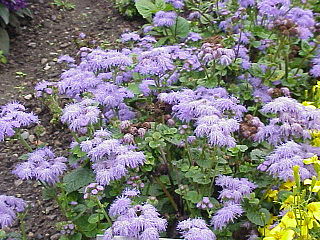Loading AI tools
Genus of plants From Wikipedia, the free encyclopedia
Ageratum (/əˈdʒɛrətəm/)[2] (whiteweed in the US) is a genus of 40[3] to 60 tropical and warm temperate flowering annuals and perennials from the family Asteraceae, tribe Eupatorieae. Most species are native to Central America and Mexico but four are native to the United States.[3]
This article needs additional citations for verification. (December 2023) |
| Ageratum | |
|---|---|
 | |
| Ageratum corymbosum | |
| Scientific classification | |
| Kingdom: | Plantae |
| Clade: | Tracheophytes |
| Clade: | Angiosperms |
| Clade: | Eudicots |
| Clade: | Asterids |
| Order: | Asterales |
| Family: | Asteraceae |
| Subfamily: | Asteroideae |
| Tribe: | Eupatorieae |
| Genus: | Ageratum L. 1753 not Mill. 1754 (Plantaginaceae)[1] |

They form tussocks or small hills. They grow to a height of 30 inches (76 cm).[citation needed] The opposite leaves are cordate or oval, hairy or tomentose. The margins are slightly toothed or serrate. The leaves form compact clusters.[citation needed]
The fluffy flowers are lavender-blue, pink, lilac, or white, and spread in small compound umbels. They give small, dry fruits.
Ageratums are grown for their flowers, especially A. houstonianum.
Most common ageratums, "Hawaii" for example, are a short 6–8 inches (15–20 cm) when full grown. Tall ageratum are also available in seed catalogues. They are about 18 inches (46 cm) in height with blue flowers.[4][failed verification] There is also a medium-height snowcapped variety, white top on blue flowers. The blues are most popular and common, but colors also include violet, pink and white. Their size and color makes ageratums good candidates for rock gardens, bedding, and containers. They grow well in sun or partial shade, from early summer to first frost. They are quite easy to grow, producing a profusion of fluffy flowers all season long.
Several species of Ageratum are toxic, containing pyrrolizidine alkaloids. Ageratum houstonianum and Ageratum conyzoides cause liver lesions and are tumorigenic.[5][6][7][8]
Ageratum conyzoides and Ageratum houstonianum are prone to becoming rampant environmental weeds when grown outside of their natural range.[9][10]
As of July 2020[update], Plants of the World online has 40 accepted species:[11]
Selected synonyms include:
The genus Paneroa consists of one species, Paneroa stachyofolia, native to Oaxaca, which was first described in Ageratum but which seems to be more closely related to Conoclinium and Fleischmannia.[12]
Seamless Wikipedia browsing. On steroids.
Every time you click a link to Wikipedia, Wiktionary or Wikiquote in your browser's search results, it will show the modern Wikiwand interface.
Wikiwand extension is a five stars, simple, with minimum permission required to keep your browsing private, safe and transparent.